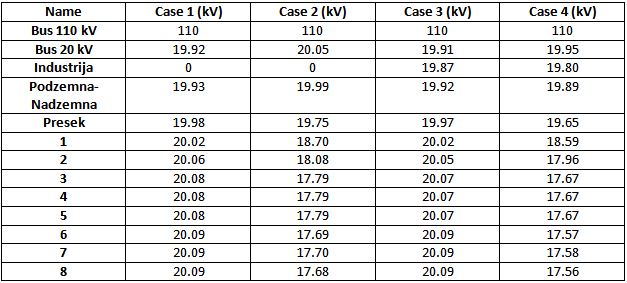
You too can share your experiment and be published in the blog, just send a mail to the team!
Introduction
The general purpose of this article is to compare several ways of compensation of reactive power in middle voltage power lines in order to determine the optimal technical and economical solution. In this article I am going to examine middle voltage power line which is fed from 110/20 kV/kV transformer station. Load flow analyses will be made for different cases and loads for the transformer station. According the results from the analyses the optimal technical solution will be determined.
To be more specific, for the purpose of the article, I am going to analyze 20kV point of a 110/20 kV/kV transformer station, on which several 20/04 kV/kV transformer stations with specific loads are connected. The following cases will be examined:
The first case is when the consumers in the network are minimally loaded and the second case is when they are fully loaded. The other two cases are when we have big consumer (so called industrial consumer) connected to the power network.
Power flow analysis of a long middle voltage power line
The power line that I am examining in this article consists of 13 nodes, from which 8 are transformer substations, and are marked with numbers starting from 1 to 8 on the picture 1, which represents the sample network that was examined.

Picture 1. Sample network in InterPSS software
As I mentioned before, a node with name “Industrija” has been added to the sample network. This node represents consumer. The other part of the network is represented with slack node. To simplify the network and the time for calculation, I presented the consumers as PQ nodes.
The results from the finished analysis with the four cases is presented in table 1.

Table 1. Active and reactive power load flow analysis
In table 2, all voltages in the nodes that are analyzed are presented.

Table 2. Voltages in the sample network
According the results from the two tables, you can see that the cases 1 and 3 are the ones that are mostly unacceptable for the analysis. In this case it means that the reactive power has opposite flows towards the 110 kV network. We can also note that the voltage at the end of the section is higher than the one on the HV/MV buses (HV-High Voltage, MV – Middle Voltage).
The voltage is higher due to the great length of the power lines, which generate reactive power that cannot be spent in case of minimum load, as the case I have been analyzing.
If you can see from table 2, the voltages are nearly the same as the nominal voltage, which is a sign that reactive power compensation should be used, in order to stop the flow of reactive power compensation towards the transformer HV/MV.
As for the cases 2 and 4, we can see that there is some voltage drop at the ending points of the network. In these points, the voltage level is between 88-90% of its nominal value. This brings up a logical conclusion, that in cases 1 and 3 active power losses should be smaller than the losses in cases 2 and 4.
You can also note that the power losses are with negative value, which means that the power lines generate more reactive power than they could spend.
Technical and economic analysis of the provided solution
In order to compensate the reactive power, some of the most common technical solutions that are used are compensating batteries, synchronous compensators and reactors.
According the characteristics of the system, I decided that the best technical solution for this network is the Synchronous compensator, because of the fact that we have different cases of work, which depend on the power load of the system, as I mentioned before.
For different power loads, the system injects or absorbs reactive power. This solution is most suitable, because it compensates the reactive power at any moment. However, this solution is the most expensive.
There is another way to solve the problem of reactive power compensation. If compensating batteries are used, the solution would be much cheaper and the effect will be similar. I am saying this because of the fact that the power load is greater in one short period of the year (that is during the winter), while in the rest of the year the load is significantly lower.
Therefore, much cheaper and of course good solution, would be installing a serial compensating battery in the most vulnerable point, which will compensate the reactive power during the greater period of the year, and in the shorter period of the year will not be used.
Conclusion
From the four cases that I have described (minimum power load, full power load, minimum with additional power load, and fully loaded with additional power load), we can draw a conclusion that the active power losses are proportional to the load (they are greater when the load is greater), while the reactive power losses are significantly lower (the power line is generating reactive power into the system, much more than the system could absorb). Nevertheless, by increasing the load, the reactive power losses increase.
Thanks for reading me guys!
Mile.
What do you think about Mile’s article and conclusions? Tell him in the comments section now.
This article is very informative. Thanks for sharing.
Great article and also very informative.. Thanks for sharing..